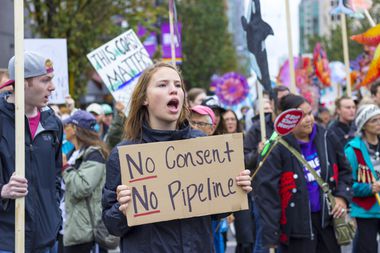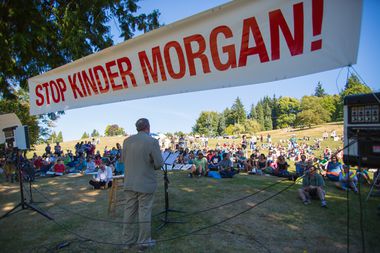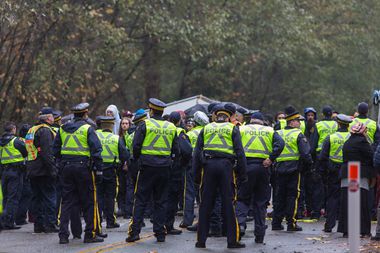Trans Mountain Oil Pipeline
| This article is part of the Global Fossil Infrastructure Tracker, a project of Global Energy Monitor and the Center for Media and Democracy. |
| Sub-articles: |
Trans Mountain Oil Pipeline or the Kinder Morgan Trans Mountain Pipeline System, is a controversial oil pipeline that carries crude and refined oil from Alberta to the west coast of British Columbia, Canada. It is wholly owned by the Canadian division of Kinder Morgan Energy Partners (Kinder Morgan) and has been in use since 1953. It is the only pipeline to run between these two areas.[1]
Contents
Location
The pipeline runs from Edmonton, Alberta, to Burnaby, British Colombia.
Project Details
- Operator: Canada Development Investment Corporation, 100% (formerly owned by Kinder Morgan)
- Current capacity: 300,000 barrels per day
- Proposed capacity:890,000 barrels per day
- Length: 1,150 km
- Status: Operating
- Start Year: 1953
Background
On February 13, 1947, large oil deposits around Leduc, Alberta were discovered. The idea for a pipeline from Alberta to British Columbia, (BC), quickly emerged, driven by the growing demand for oil both in Asia and on the west coast of Canada and the West Coast of the United States. The US military was also interested in developing this infrastructure so that oil could be accessed more easily for military use, specifically because of the ongoing Korean War.
On March 21, 1951, the Trans Mountain Pipeline Company was created by a special Act of Parliament. On the same day, the company made a pipeline proposal to the Board of Transport Commissioners. Ownership of the company was split between Canadian Bechtel Ltd. and Standard Oil.
In February 1952 after the Board´s approval, construction began. Canadian Bechtel Ltd. was responsible for engineering, design, and construction of the project. On October 17, 1953, oil began to be pumped through the pipeline, which had cost a total of $93 million.[2][3]
In 2004, Kinder Morgan began the process to add a second pipeline, running parallel to the first, for the portion running between Hinton, Alberta, and Hargreaves, British Columbia. This required two more pumping stations - the Wolf Pump Station, near Niton Junction, Alberta, and the Chappel Pump Station, near Pyramid, British Columbia.
In 2008, the project was completed, increasing capacity by 40,000 barrels per day, (from 260,000 to 300,000 barrels per day).[4]
In August of 2018, the Canadian government became the owner of an active pipeline a business that generates revenue and expenses when it acquired the Trans Mountain pipeline from Kinder Morgan.[5]
Environmental Impact and Spills
In the period 1961-2016 there were 82 reported spills along the Trans Mountain pipeline[6] as well as other environmental accidents in the area of the already-existing pipeline, including:
- Abbotsford 2005: A ruptured pipeline dumped 210 cubic meters of crude oil. The company attributed the accident to activity on a neighboring property.[7]
- Burnaby 2007: A contractor working on a sewage project for the City of Burnaby ruptured a pipeline, causing spillage of 224-234 cubic meters of crude oil, some of it flowed into Burrard Inlet via the Burnaby storm sewer system, most of it was recovered. Eleven houses were sprayed with oil, and about 225-250 residents were evacuated or left voluntarily. Cleanup took more than a year.[8][9]
- Burnaby 2009: 305 cubic meters of crude oil were released from a tank at the Trans Mountain Burnaby Terminal, most of it flowed into a containment area.[10]
- Sumas 2012: 90 cubic metres of light crude oil leaked from a Sumas Mountain holding tank, all of it flowed into a containment area.[11]
The existing and proposed pipelines transport diluted bitumen through the Strait of Juan de Fuca, an extremely sensitive environmental region. The tankers have to pass through a very narrow channel of shallow water to reach the open sea, making the project controversial and strongly opposed by the Council of Canadians.[12]
Members of the Squamish and Tsleil-Waututh First Nations of British Columbia paddled canoes on the waters of Burrard Inlet to the Kinder Morgan Burnaby Terminal for a ceremony to protest the expansion of the Trans Mountain pipeline, in North Vancouver, B.C., on September 1, 2012. Tsleil-Waututh leaders hoped to shut down the project altogether.[13]
Other projects
The pipeline is part of multiple projects to increase the export of Canadian oil to international markets, as well as to Eastern Canada and to refineries around North America. Other projects include the Northern Gateway Pipeline from Alberta to Kitimat, the Keystone XL Pipeline to the Southern US, and Line 9 and Energy East to eastern provinces.
Expansion Project Details
- Operator: Canada Development Investment Corporation, 100% (formerly owned by Kinder Morgan)
- Proposed capacity: 590,000 barrels per day
- Length: 980 km
- Status: Construction[14]
- Start Year: 2022[14]
Expansion Background
In 2013, Kinder Morgan filed an application with the Canadian National Energy Board to build a second pipeline under the Trans Mountain Pipeline Expansion Project.[15] The second pipeline was to run roughly parallel to the existing pipeline, between Edmonton and Burnaby, (east of Vancouver), and to be used to transport diluted bitumen. The additional pipeline requires 12 new pumping stations. The proposed expansion, with 980 km of pipe, would increase the system's capacity from 300,000 to 890,000 barrels per day. An investment of $6.8 billion would complete the connection between Strathcona County, Alberta, and Burnaby, British Columbia.[16]
Kinder Morgan had the support of several large petroleum industry customers for this expansion, including BP Canada Energy Trading Co., Canadian Natural Resources, Canadian Oil Sands Ltd., Cenovus Energy Inc., Devon Canada Corp., Husky Energy Marketing Inc., Imperial Oil Ltd., Nexen Marketing Inc., Statoil Canada Ltd., Suncor Energy Marketing Inc., Suncor Energy Products Partnership, Tesoro Refining & Marketing Co, and Total E&P Canada Ltd.
In 2016, the BC government said that it did not support Trans Mountain, partly because Kinder Morgan had not provided enough information about its proposed spill prevention program.[17]
On November 29, 2016, Canada's federal cabinet approved the expansion project, announcing that the approval was "subject to 157 binding conditions that will address potential Indigenous, socio-economic and environmental impacts, including project engineering, safety and emergency preparedness. This $6.8-billion project will create 15,000 new jobs during construction."[18]
Despite federal government approval, seven Federal Court challenges have been filed by the municipalities of Vancouver and Burnaby, and the Tsleil-Waututh, Suquamish, Kwantlen, and Coldwater First Nations.[19]
In August of 2018, the Canadian government became the owner of an active pipeline a business that generates revenue and expenses when it acquired the Trans Mountain pipeline from Kinder Morgan.[5]
Environmental Impact and Spills
The existing and proposed pipelines transport diluted bitumen through the Strait of Juan de Fuca, an extremely sensitive environmental region. The tankers have to pass through a very narrow channel of shallow water to reach the open sea, making the project controversial and strongly opposed by the Council of Canadians.[20]
In the period 1961-2016 there were 82 reported spills along the existing Trans Mountain pipeline[6] as well as other environmental accidents in the area of the already-existing pipeline, including:
- Abbotsford 2005: A ruptured pipeline dumped 210 cubic meters of crude oil. The company attributed the accident to activity on a neighboring property.[21]
- Burnaby 2007: A contractor working on a sewage project for the City of Burnaby ruptured a pipeline, causing spillage of 224-234 cubic meters of crude oil, some of it flowed into Burrard Inlet via the Burnaby storm sewer system, most of it was recovered. Eleven houses were sprayed with oil, and about 225-250 residents were evacuated or left voluntarily. Cleanup took more than a year.[22][23]
- Burnaby 2009: 305 cubic meters of crude oil were released from a tank at the Trans Mountain Burnaby Terminal, most of it flowed into a containment area.[24]
- Sumas 2012: 90 cubic metres of light crude oil leaked from a Sumas Mountain holding tank, all of it flowed into a containment area.[25]
Economic Impact
A study by Simon Fraser University claims that Kinder Morgan has overestimated the economic benefits of the pipeline expansion.[26]
Opposition
The expansion project faced strong opposition from civic governments, First Nations, environmentally concerned citizens, and others. Protests in November 2014 focused on Kinder Morgan's surveying work.
Members of the Squamish and Tsleil-Waututh First Nations of British Columbia paddled canoes on the waters of Burrard Inlet to the Kinder Morgan Burnaby Terminal for a ceremony to protest the expansion of the Trans Mountain pipeline, in North Vancouver, B.C., on September 1, 2012. Tsleil-Waututh leaders hoped to shut down the project altogether.[27]
Articles and resources
References
- ↑ Transmountain | About Us. Archived from the original on June 17, 2016.
- ↑ APPENDIX A: OIL PIPELINE TIMELINE. Archived from the original on March 5, 2017.
- ↑ TransMountain (2010-06-20). Oil Across The Rockies -PART 1.wmv. Retrieved on 2016-12-01.
- ↑ Transmountain | Anchor Loop. Archived from the original on June 16, 2016.
- ↑ 5.0 5.1 Template:Http://ieefa.org/wp-content/uploads/2019/04/Trans-Mountain-Pipeline-Financials April-2019.pdf"Trans Mountain Pipeline Financials: Built on Quicksand and Clear as Mud" IEEFA. accessed April 17, 2019.
- ↑ 6.0 6.1 Releases Reported by Trans Mountain - 1961-2016. Transmountain (August 31, 2016). Archived from the original on December 21, 2016.
- ↑ Abbotsford - Sumas Facility: Ward Road Spill. Transmountain. Archived from the original on December 1, 2016.
- ↑ Westridge 2007 spill. Transmountain. Archived from the original on December 1, 2016.
- ↑ Pipeline Investigation Report P07H0040. Transportation Safety Board of Canada. Archived from the original on June 13, 2017.
- ↑ Burnaby Tank 82 2009 Spill. Transmountain. Archived from the original on December 1, 2016.
- ↑ Abbotsford - Sumas Facility: Tank 121 2012 Spill. Transmountain. Archived from the original on December 1, 2016.
- ↑ No Pipelines! No Tankers!. The Council of Canadians. Archived from the original on August 5, 2017.
- ↑ Canadian Televisions News. Archived from the original on May 8, 2014.
- ↑ 14.0 14.1 Trans Mountain Re-Starts Construction on Expansion ProjectTrans Mountain, August 21, 2019
- ↑ About Us | Trans Mountain. Archived from the original on September 28, 2015. Retrieved on 2015-09-27.
- ↑ Transmountain | Proposed Expansion. Archived from the original on April 23, 2016.
- ↑ Trans Mountain pipeline expansion not supported by B.C. government. CBC News (January 11, 2016). Archived from the original on December 7, 2016.
- ↑ Government of Canada announces pipeline plan that will protect the environment and grow the economy. Government of Canada (2016-11-29). Archived from the original on December 1, 2016.
- ↑ Hoekstra, Gordon (2016-11-26). Yes could still be no as Kinder Morgan awaits Trudeau's nod on its multibillion-dollar pipeline expansion. The Vancouver Sun. Archived from the original on December 9, 2016.
- ↑ No Pipelines! No Tankers!. The Council of Canadians. Archived from the original on August 5, 2017.
- ↑ Abbotsford - Sumas Facility: Ward Road Spill. Transmountain. Archived from the original on December 1, 2016.
- ↑ Westridge 2007 spill. Transmountain. Archived from the original on December 1, 2016.
- ↑ Pipeline Investigation Report P07H0040. Transportation Safety Board of Canada. Archived from the original on June 13, 2017.
- ↑ Burnaby Tank 82 2009 Spill. Transmountain. Archived from the original on December 1, 2016.
- ↑ Abbotsford - Sumas Facility: Tank 121 2012 Spill. Transmountain. Archived from the original on December 1, 2016.
- ↑ Canadian Broadcasting Corporation (10 November 2014). Archived from the original on December 4, 2016.
- ↑ Canadian Televisions News. Archived from the original on May 8, 2014.
Related SourceWatch articles
Trans Mountain Oil Pipeline Expansion
External resources
Wikipedia also has an article on the Kinder Morgan Trans Mountain Pipeline System. This article may use content from the Wikipedia article under the terms of the GFDL.


